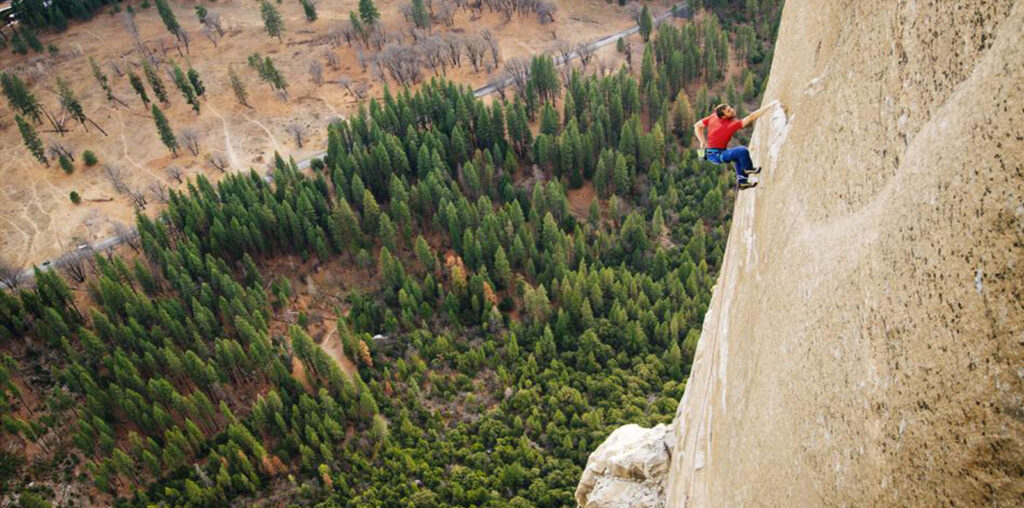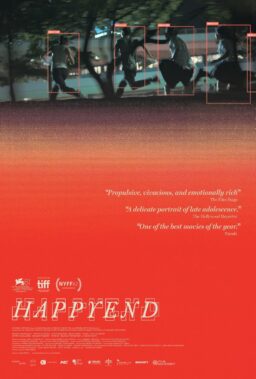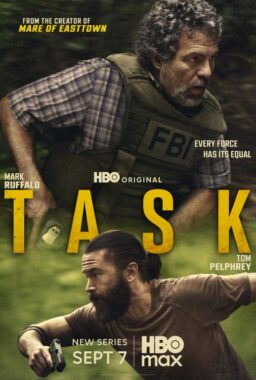Fans of epic cinema will want to climb mountains with their bare hands after seeing “The Dawn Wall,” a documentary worthy of IMAX about two buddies free-climbing the side of El Capitan in Yosemite National Park. In January 2015, Tommy Caldwell and Kevin Jorgeson decided to climb the 3,000 foot rock face, using only their hands and tethers going from one designated hook to the next (called a “pitch”), after years of practice. They both speak about the experience with smiles on their faces, so we know that nothing horrible happens to them, but the footage of them climbing—captured over many years—is purely invigorating. As the most genuine of crowd-pleasers, it will have you rooting instantly for the two hardworking, charismatic athletes. You’ll start to root for the filmmaking, too.
The adventure took weeks, sometimes with full days spent just hanging on the side of the rock as the world watched, and features dramatic turns. That’s before we learn about previous chapters in Caldwell’s life; a former kidnapping in Kyrgyzstan, a sliced finger (a horrific injury for climbers in particular). In a scale as small as friendship or as large as the rock itself, vivid ideas of endurance and overcoming obstacles make this doc a beauty, while “The Dawn Wall” offers incredible imagery of them climbing, as assembled with a strong editorial rhythm. It’s all coated with an undeniable good spirit, like an adrenaline shot with a lot of soul, too.
“The Dawn Wall” is basically an adventure of ambition and obsession in nature worthy of a Werner Herzog film. But without being blasphemous, “The Dawn Wall” directors Josh Lowell and Peter Mortimer do it better than Herzog could have done, specifically because of how “The Dawn Wall” shines for having the intimacy of a first-person perspective instead of that of a curious outsider’s. The value of friendship and hard work goes beyond just Tommy and Kevin but to the filmmakers, who we can see in only select moments also on the mountain, hanging off the side of the Dawn Wall in what becomes their obsession, too.
The focus and effort that went into this documentary make even the most repetitive of passages ache with hope and anxiety: there’s an extensive amount of time during the climb where Kevin can’t make it from one pitch to the other, and practices over and over to get across the rock in a way that must be precise. He tries, he fails, he tries again, and so on. Instead of holding the film’s pacing down, it becomes a gorgeous, definitive microcosm for the power of this story, which excels in capturing scope as small as a dedicated friendship, or as massive as the Dawn Wall itself.

A different kind of invigoration can be found within “They Live Here, Now,” which tells of an Austin, TX refugee house for new immigrants. While the geographical connection to SXSW is convenient, but the story is as local as whatever town you’re currently in, given the importance it has to how we treat people who enter our country in hope of some type of life.
The doc starts with the gesture of representation, especially articulated by that clear-cut title, but it becomes more than that as their stories are shared. Among the semi-bustling quarters of the Casa Marianella, people from the likes of Mexico, Cameroon, Peru, Iraq and other countries talk about how they came to America and then to the shelter, delivering them like nervous monologues. The camera remains still and hardly cuts during these passages, capturing people in a state of purgatory, alarming us to their backgrounds. Every person has a story, some stories beyond even their own comprehension, and it’s a gripping experience (for the 60-minute runtime) to hear them. Director Jason Outenreath balances these sobering passages with small examples of hope, found in shots of the workers (all women) trying to assist people like Nayali (who came from Mexico and is looking for her father) or teaching English to a room full of people from different continents and languages. There are many moments in which “They Live Here, Now” subtly offers examples of how the refugee crisis can be handled—with compassion and respect—and will make you hope that those qualities are still considered American.
There’s a small catch to the story that isn’t articulated in the movie but in the press notes, regarding how Outenreath cast some of the people here and wrote the words they speak, nonetheless as inspired by real accounts. It proves an interesting choice, and within the story it does work, along with make the people exist as messages to be heard and felt, loud and clear. But I don’t think a note about that artistic choice would take away from its meaningfulness, especially as “They Live Here, Now” already wisely yearns for a more expressive bent than normal when documenting so many life stories.












